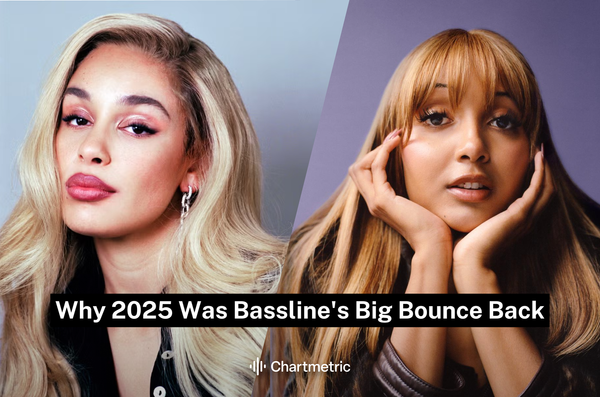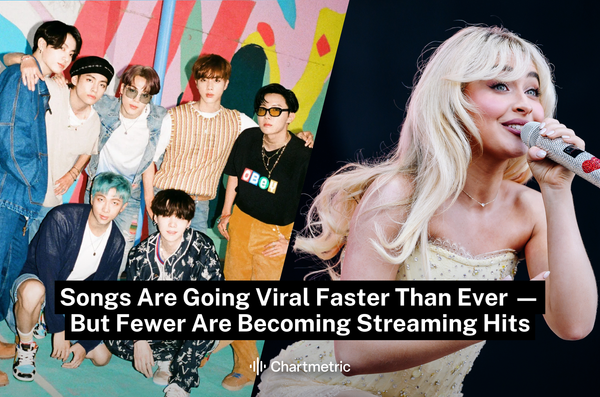With the rising travel and accommodation costs, historically low ticket sales, and increasingly restrictive visa regulations in countries like the US and the UK, artists across the globe are facing mounting barriers touring their music. As the past few years have shown, it’s not just emerging artists opting out, either—mid-level and even superstar performers are also seeing a noticeable decline in their tour schedules.
An analysis of the top 1k artists from each career stage in 2022 and 2024—defining “touring artists” as those who performed at least ten shows in one year’s time—shows a steep decline. Between these two years, the share of mid-level touring artists decreased from around 19% to 12%. Among superstars, touring numbers went down at an even higher rate, from 44% to 36%.
These numbers indicate that star power alone no longer guarantees a successful tour. A number of famous artists cancelled their tours last year due to low ticket sales, including Jennifer Lopez, The Black Keys, and Lauryn Hill & Fugees. Big festivals are feeling the pinch as well, as many fans who may have once had the spare funds to indulge in live music are no longer in the same position to afford tickets. Even Coachella, which once regularly sold out within hours, took almost a month to sell out in 2024. In 2025, more than half of the festival's GA attendees utilized payment plans to secure their tickets.
Not every artist can make off with over $2 billion in sales like Taylor Swift did with her Eras tour. Between 2023 and 2024 Swift performed 149 shows, with an average ticket price of about $204 per seat. The highest recorded ticket price was for the closing night of the entire Eras tour, at her December 8th show in Vancouver, marked at over $14,000.
If you’re not Taylor Swift, organizing a tour in 2025, a year in which the US is at a 60% chance of recession, poses a critical question for artists of all levels of fame. Financially, is it worth it to tour? Potentially not. But for those who are still making the effort to tour, the draw may consist of more than a paycheck.
Making The Most of Modern Touring
To string instrumentalist Jason Dungan—who goes by Blue Lake both in his solo project and his collaboration with other Copenhagen-based musicians—playing shows is a necessity. “I love live music so much,” he told Chartmetric. “I think it’s almost impossible for me to imagine not wanting the music to have a live component.”
Dungan began experimenting playing and building string instruments during the pandemic, including a 48-string zither. He stayed local to Copenhagen both as a musician and an event organizer for a number of years, before embarking on his first international tour of ten shows in 2024. He noted that his partnership with London-based independent label Tonal Union played a large part in giving Blue Lake more capacity to book shows. It was also with Tonal Union that Dungan released Sun Arcs, an album which made Pitchfork’s “Best New Music” list in 2023, as well as his most recent album, Weft.
In earlier years, Blue Lake mainly played in an improvisational style. After Sun Arcs was released, the group began to play the album for shows. Dungan described that pivotal concerts—such as the group’s performance at London’s Cafe OTO in October 2023—have changed his perspective on touring and playing live.
“It makes you ask serious questions about the music, because when you’re playing in a big room like that, you have to think about the kind of gestures you make,” he described. “I think it’s made me more interested in clarity.”
This year, Dungan shared that he is planning a US tour, made possible in part with funding aid from the Danish government. Due to the expense of artist visas, however—the cost of which almost quadrupled from $460 to $1615 per musician last year, in the first bump since 2016—Dungan has opted to tour with a group of New York musicians in place of his core band in Copenhagen. He described the financial obstacles as more akin to an opportunity to think outside of the box, rather than a deal-breaker for playing live.
“Sometimes the money [constraints] can be helpful, because it’s a limitation like anything else, and it can force you to think about things in a different way,” says Dungan.
What If You Don’t Want To Tour?
At the very least, playing live remains a viable means for gaining exposure. In 2024, for example, Jane Remover co-headlined with labelmate and fellow hyper-rock artist, quannnic, on a US tour. Over the course of the 12-date tour in the month of February 2024, quannnic gained almost 30k new monthly listeners on Spotify - their first boost after several major releases in 2023.
On the other hand, some artists may not find touring necessary, nor to be worthwhile. Clarence Clarity told Chartmetric this year that he prefers to focus on studio work. Chartmetric also spoke with Keith Rankin of Giant Claw and death’s dynamic shroud, who expressed that he actively avoids touring whenever possible. Instead, with the two other members of death’s dynamic shroud, Rankin runs the NUWRLD Mixtape Club, for which the three take turns creating new releases every month—though the other two members often still tour.
Thankfully, exposure today doesn’t depend on live shows alone. In the technology age, there are more ways than ever for artists to gain an audience and sell their music. One common opportunity is through music synchronization, or “sync,” meaning the pairing of music with visual content. Through sync deals, artists have the chance to increase their income stream as well as their exposure to the given audience watching a film, TV show, advertisement, or playing a video game.
As Simon J Karis, musician and head of the indie label Nice Music told Chartmetric, his efforts to find syncing opportunities have resulted in licensing deals featuring a number of tracks of his and the label’s artists. This includes two tracks of from artist J. Campbell’s album Erosion of Memory for a YouTube video project featuring Australian snowboarders, as well as a pending opportunity for a track of Karis's to be featured in an A24 film.
Where the Industry Goes Next
As music industry analyst Bob Lefsetz put it in his blog post “Old School/New School”: “OLD SCHOOL: The tour was an advertisement for the album. NEW SCHOOL: The album is the advertisement for the tour.”
Lefsetz’s observation indicates that ever since the advent of streaming, which gives easy access to the album, the function of touring has changed, and become relatively decentralized from the listener's experience. However, the decentralization of touring does not stem from a desire of fans to see less live music, nor a desire of artists to tour less, but rather as the result of systemic issues that leave both groups in the lurch.
Governments can help protect the live industry by taking action to support touring infrastructure. This includes funding to help more artists to feasibly tour and make attending shows more attractive and accessible for fans, as well as protecting local music venues from the threat of closure.
In service of the latter, the UK government has recently taken a proactive step with the UK Live Trust, which reallocates money from stadium and arena concerts to smaller venues by donating £1 per ticket sold at larger venues.
With major touring artists including Diana Ross, Pulp, Hans Zimmer and Mumford & Sons already taking part, the funding pool has so far accumulated over £500k. UK Member of Parliament Jeremy Corbyn has also announced ‘A Summer To Save Music,’ a grassroots concert series organized by Corbyn’s Peace & Justice Project. “What this demonstrates is that there is a real appetite from performers and their teams to support the wider live ecosystem,” said Live CEO Jon Collins. “[Though] there is still much work to do.”
Going forward, established musical acts are also expected to play an important role in offering opportunities for exposure. “Slots at larger concerts are very significant in getting support for emerging artists,” notes the COO of Music Ally, Patrick Ross, on the Music Ally Pro platform. He references the success of Holly Humberstone’s tour last year, which hosted artist Medium Build as a special guest. Medium Build’s slot on the tour brought the artist’s performance across streaming and social platforms to a similar level to Humberstone’s.
Ross also predicts that globalization of touring will become more prevalent, with a number of big acts touring Asia this year including Lady Gaga, Tyler, The Creator, Blackpink, Coldplay and Oasis. Given the high price of tickets, there is also increased incentive to make the live experience more appealing to fans, including a focus on creating unique moments at shows, as well as offering VR streaming as an option for fans who are not able to attend in person.
Ultimately, the live industry should exist to serve artists and audiences—not just growth for the sake of itself. “I feel like the music industry is often based on this idea that things are always getting bigger,” described Blue Lake. For him, the feeling of a live show is an experience like no other. “There’s something quite intimate about doing this, [something] quite powerful. It’s very satisfying and very exciting. It gives you a hunger to want to make those things happen.”






